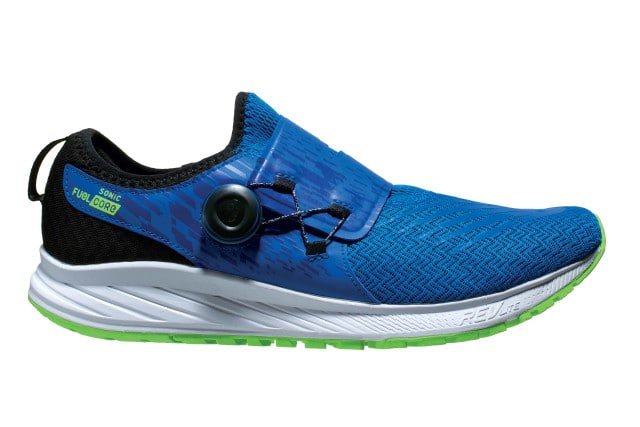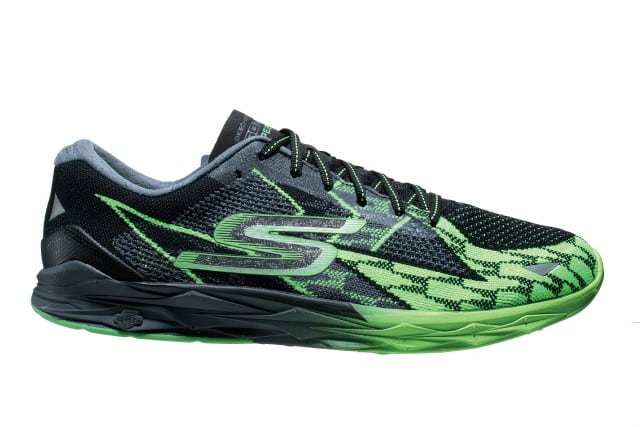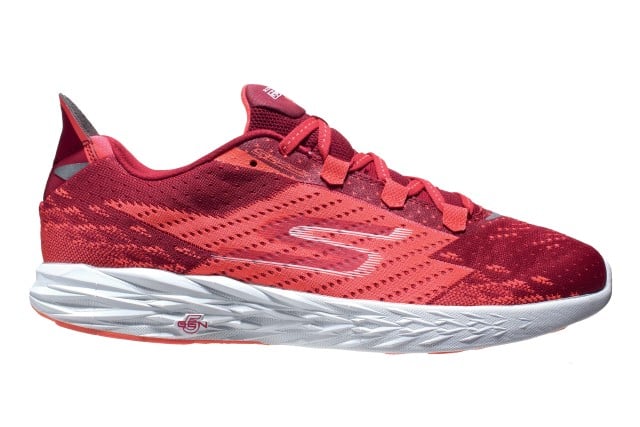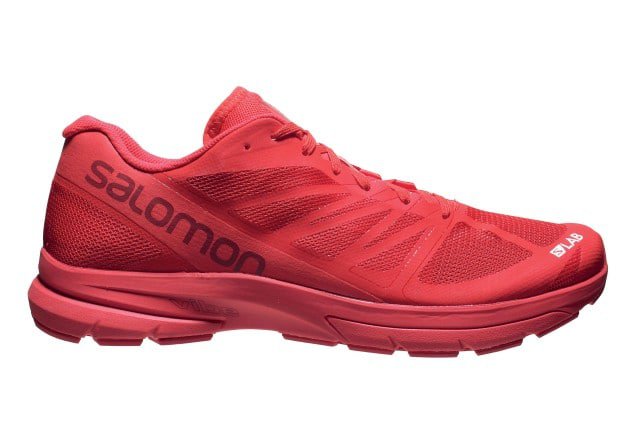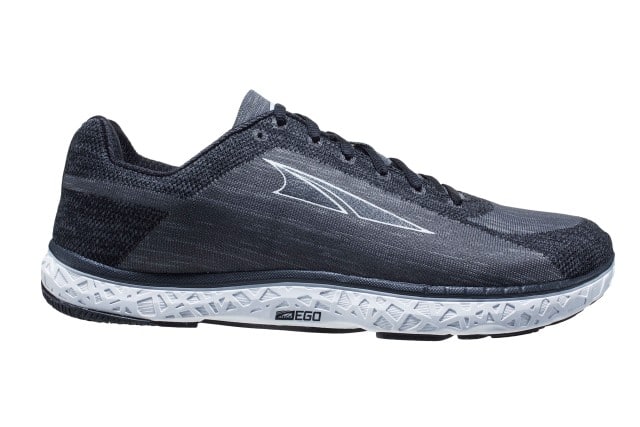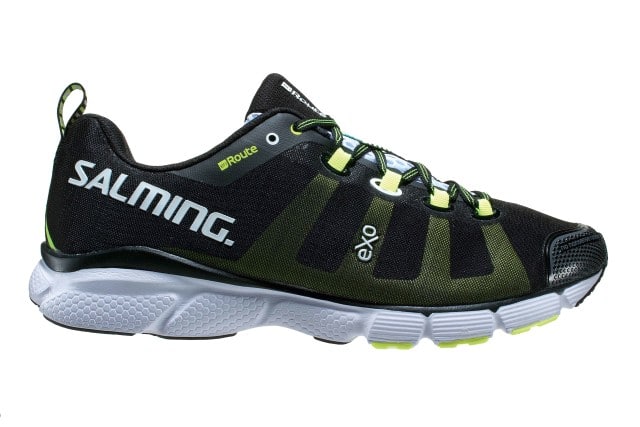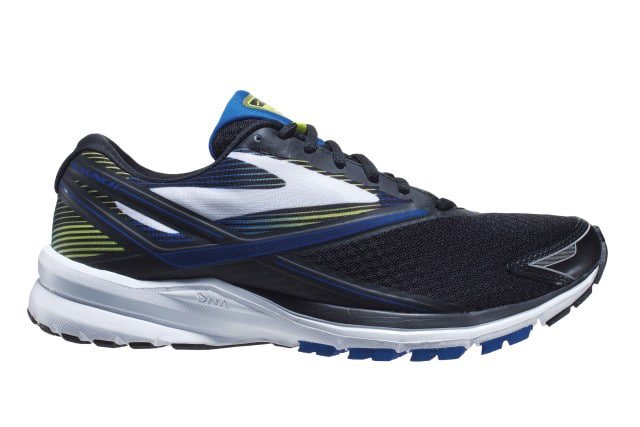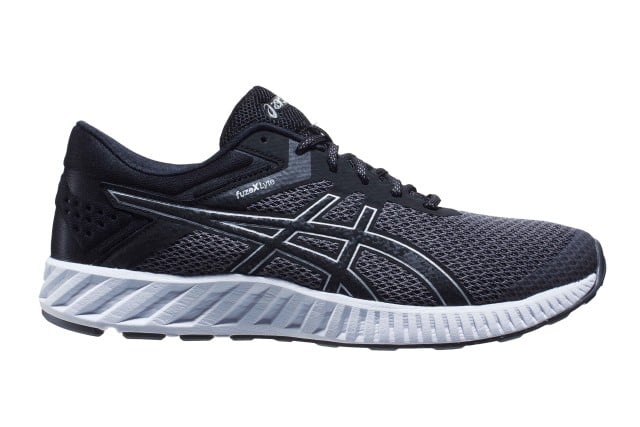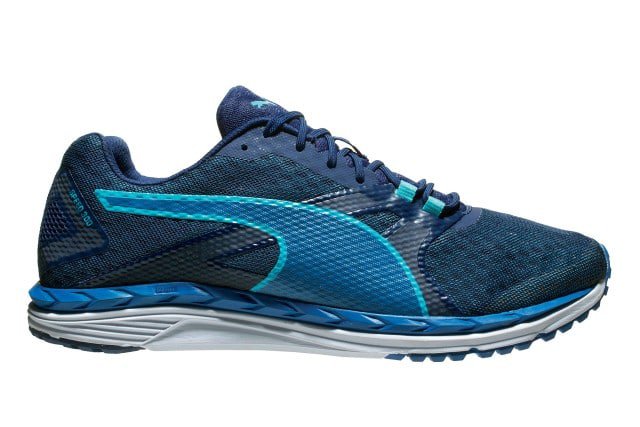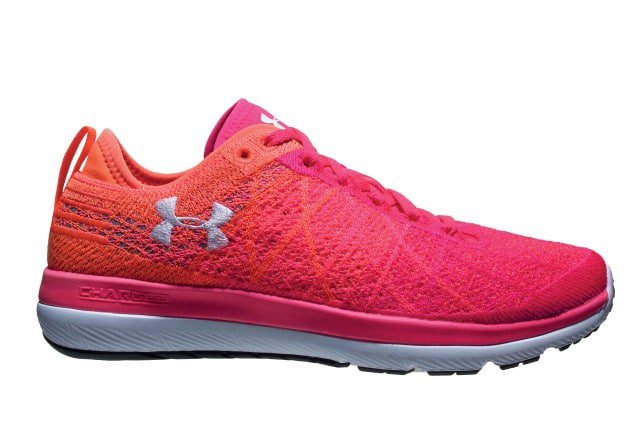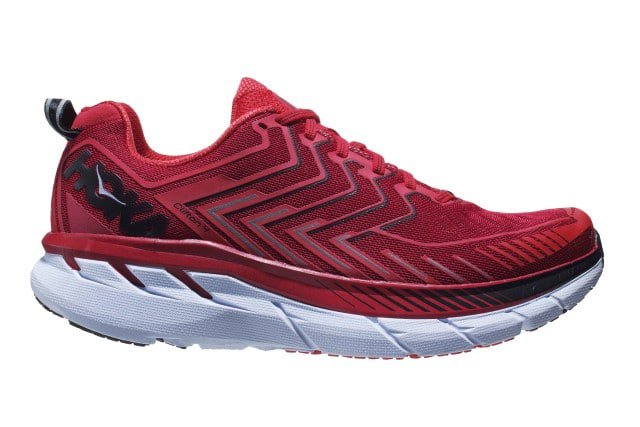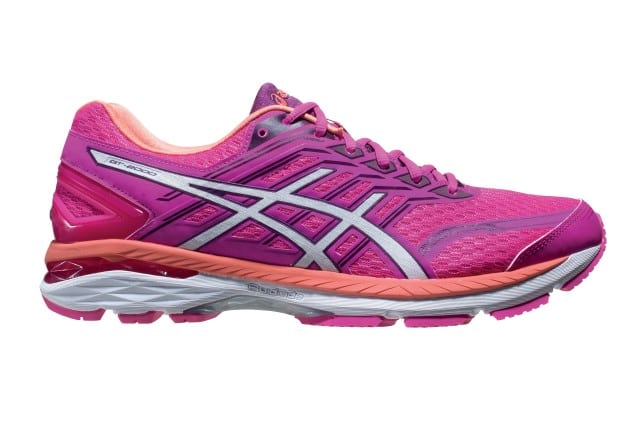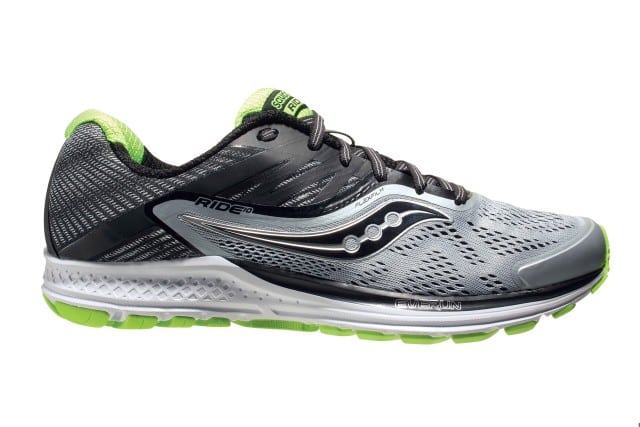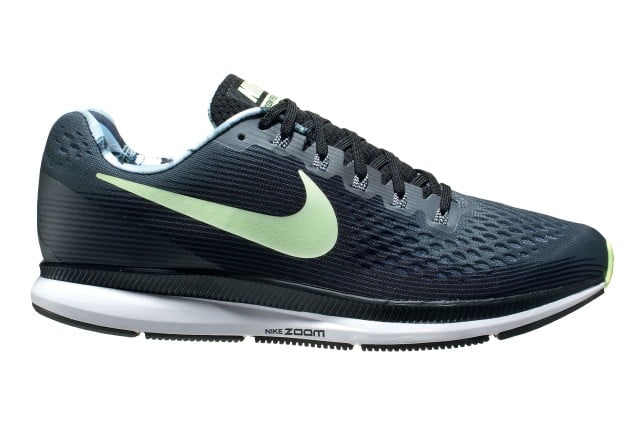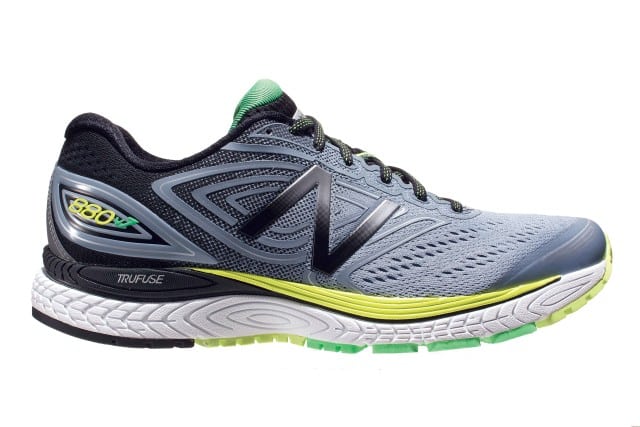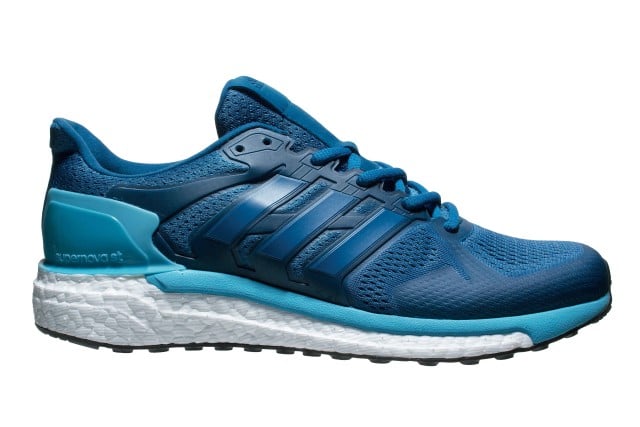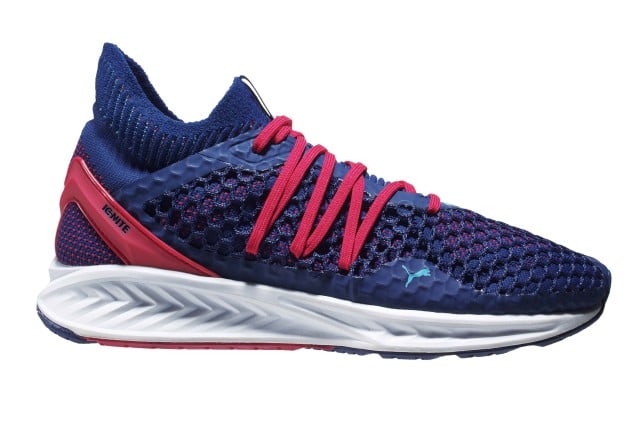The Ultimate Spring Shoe Buyer’s Guide!
Our team of wear-testers put the latest models through their paces on roads around the country, to help you find your perfect pair.
Our team of wear-testers put the latest models through their paces on roads around the country, to help you find your perfect pair. By Ryan Scott & Dr Martyn Shorten, Photographs by James Garaghty
Road-running shoes are lighter: only three of the shoes we’ve tested this spring weigh more than 300g, and seven weigh less than 250g. That’s because brands such as Under Armour have made shoes from thinner, stronger materials, and others such as Puma have introduced lightweight cushioning in their foams.
New Balance Sonic Fuel Core: R2 200
It’s an all-new design and look from New Balance. Most notably, the new BOA fit system takes the place of traditional lacing, much like the Puma Disc system we saw re-introduced in 2016. Tightening and adjusting the system for a specific fit happens with a few clicking rotations to lock the foot down securely and comfortably, via an overlay strap. (The two release mechanisms, at 180° departures from each other, were a little less user-friendly.) The rest of the shoe’s impressive performance is reminiscent of the NB Vazee Pace; so fans of that shoe will definitely enjoy this new option, which is also good for performance training over all distances.
Weight: 243g
Skechers GOmeb Speed 4: R1 849
Firm and fast, the GOmeb Speed 4 is best suited to tempo runs and road races – though if you’re an efficient runner like Meb Keflezighi, you can get away with racing a marathon in it. To create a snappy, go-fast feeling, Skechers uses a thermoplastic plate embedded in the midsole foam. That’s unchanged from the earlier version, but just about everything else you see has been updated. The upper is now flat-knit with hot-melt yarn, to provide a secure, comfortable fit. And the sole is no longer the pillar design that has marked Skechers shoes since their launch. Instead, the sole makes full ground contact and has a durable, 2mm-thick web of rubber for traction on the heel and forefoot.
Weight: 192g
Skechers GORUN 5: R1 499
Skechers stuck with ‘4’ as the model number for two years, because tweaks to the last version were too minor to warrant a new digit. This year, some smart updates have refined the fit and underfoot feel of an already sound shoe. An updated circular-knit upper brings the materials closer to the foot, while ample venting lets the shoe breathe – much as we’re seeing with all of the engineered-mesh uppers. Testers raved about the fit, which remained comfortable even at the end of a long run, when feet are swollen. The bottom of the shoe also has a new look, with a thin web of rubber replacing the pods of earlier models. This gives the shoe more surface contact with the pavement.
Weight: 213g
Salomon S-Lab Sonic 2: R2 599
This season we’re taking note of Salomon’s new Vibe technology, which – like compression socks – is aimed at reducing muscle vibration, to help avoid injury; but at the same time, it increases energy return. This happens in the midsole, where soft, lightweight Opal cushioning interacts with springy EnergyCell materials. This is also the first Salomon shoe to include a geometric decoupling mechanism, which helps with a smoother ride as your foot transitions. Endofit technology has been used to create a light, uncomplicated upper, which offers high-performance road runners a secure fit. Testers found the Sonic best suited to narrower feet.
Weight: 216g
Altra Escalante: R2 399
Testers raved about how comfortable the Escalante felt; many declared it the best Altra has built to date. Boasting the company’s first flat-knit upper and an all-new bouncy midsole compound, the Escalante offers a responsive, go-fast sensation in training. The new midsole foam is about as springy as it gets, returning more energy than the adidas Supernova ST (which uses Boost) and the Saucony Ride 10 (which uses a full-length layer of Everun). Long-time Altra wearers will be happy to note that the shoe shares a last (the foot-shaped form that a shoe is constructed around) with the Torin and the One, so you get a familiar, comfortable fit. But it also has the same stack height as the Instinct, for a midrange level of protection and road feel.
Weight: 227g
Salming En Route: R2 720
The name may be brand-new in South Africa, but this Swedish company has been building shoes for court sports such as touch rugby and squash for a long time. Now they’ve turned to creating unstructured, low-to-the-ground, firm and lightweight running shoes – such as the racy Salming Race 5, for PB-chasers. This new En Route model has a more mainstream form than some of the earlier Salming road shoes, with a soft heel and plastic torsion unit in the midfoot for added structure. The midsole features Salming’s version of a bouncy EVA. For a training and long-distance shoe, it’s lightweight, and the thin upper helps keep the foot cool.
Weight: 255g
Brooks Launch 4: R2 149
A peppy daily trainer from Brooks, the Launch has a firm heel and flexible forefoot that enables you to run fast when the mood strikes. This update has more blown rubber in the forefoot than the previous version, delivering a softer (and quieter) landing, while also shaving off some weight. An extra flex groove up front makes the shoe bend much more easily for a shoe this thick, which helps make the movement from heel to toe-off a lot smoother, and more efficient and agile. The transition area of the shoe has a rigid, X-shaped band of rubber, which provides torsional rigidity.
Weight: 218g
Asics FuzeX Lyte 2: R1 400
We’ve found a zippy shoe for those up-tempo days when you feel you need the shoes to match your speed, but which will still give you versatility. The midsole and outsole remain largely untouched from the first version, delivering moderately soft cushioning from heel to toe. The upper, however, gets a new mesh package that wear-testers reported was roomy enough to remain comfortable on long runs, but compliant enough to be pulled tight if you have a narrower foot. It’s not the traditional shape and structure of the Asics shoes we know so well, but this change in shape – with a wider forefoot, and very few stability features – will appeal to those looking to run on a variety of surfaces.
Weight: 258g
Puma Speed 300 Ignite 2: R2 000
The toe-off point of the Speed Ignite (which used to be the Faas 300 Speed) has always been a distinguishing aspect of this shoe. When looking for a smooth transition in the last point of contact with the running surface, an exaggerated upturn, like the one found in the Propulsion Zone+ of this shoe, and a little less foam from the midsole, help to make the process more efficient. A one-piece upper and longer lacing area help lock the foot down; but testers using both this shoe and the Ignite Netfit commented how useful the new lacing system would be, to give an even more specific fit. To include the word ‘Speed’ in a shoe’s name means it has to be light; this shoe ticks that box, weighing in at just…
Weight: 220g
Reebok Supreme Floatride: R2 499
Reebok continues its strong return to performance running with the all-new Floatride. The highlight here is an exceptionally bouncy and lightweight midsole. In recent years, every brand has been whipping up its own version of a high-energy-return foam, and Reebok is calling its material Float Foam. In the lab, the shoe delivered incredible energy return scores, on par with some of the most cushioned adidas Boost shoes we’ve measured. On the road, that translates into a well-cushioned, responsive ride that makes you want to run fast. The upper could use a little refinement, say some of our testers; the stretchy knit used in the front half of the shoe didn’t deliver quite enough support for a few of our runners. The moulded fabric in the back half, however, does a good job of keeping your heel centred over the midsole.
Weight: 260g
Under Armour Threadborne Fortis: R2 199
The Threadborne presents an upper which reminded us a lot of a narrower version of the ever-popular Nike Free range. The idea is to let the shoe easily take on the shape of the foot, rather than the other way around. The Threadborne fabric is the finest knit we have ever seen on a shoe; it looks attractive, and contributes to the lightweight nature of the one-piece upper. The lockdown at the lacing sector of the midfoot was the most comfortable of all those tested – this is due to fine nylon yarn, which has eyelets that feel almost part of the tongue. They integrate with the internal ankle bootie to create a comfortable, snug wrap around the foot.
Weight: 268g
Hoka One One Clifton 4: R2 150
The Clifton, which has become a lightweight training shoe and racing option as well as a long-run shoe for a lot of high-mileage runners, has undergone a complete overhaul. One result is that it looks sleeker – most noticeably due to a line of paint on the midsole that makes the shoe look like it’s closer to the ground, giving the appearance of a more traditional shoe. The foam has changed too: you may sense a firmer ride underfoot. Hoka One One has tried to make this shoe more durable, so it won’t crush out as much as earlier versions did – yet every tester who picked up the shoe was surprised at how little it weighed.
Weight: 263g
Under Armour Charged Bandit 3: R1 999
At first glance, the lightweight look of the Bandit gives the impression that it won’t deliver much cushioning, but the firm heel and forefoot are very soft, and the new dual-density-charged midsole helps with a smooth transition to toe-off. The third version of the shoe is even lighter than the last, and it keeps the foot locked down with foot-form-hugging SpeedForm fabric and an external heel counter. For such a good-looking shoe, it’s a pity the plastic heel cup needs to be so prominent, as it detracts from the aesthetics of the shoe while doing its job of securing the foot. A full covering of high-abrasion-resistant rubber on the outsole adds some robust attributes where you need them most on a shoe. One last change is the profile, which has dropped from 10mm to 8mm from heel to toe.
Weight: 260g
Brooks Ravenna 8: R2 299
The Ravenna has long been a moderately supportive and cushioned shoe, capable of handling both long runs and tempo runs with ease. This year, Brooks is labelling it as one of its ‘Energize’ shoes, recommending it as the stability sister shoe to the Launch. The shoes now share a number of similarities, such as 5.5mm of blown rubber in the forefoot for a softer ride and springier toe-off, and an X-shaped patch of rubber in the midfoot that smooths the gap between heel and forefoot. A new air mesh is more breathable than previous versions, but the upper still has plenty of structure to hold the foot steady, thanks to an adjustable strap that locks into the laces.
Weight: 297g
Asics GT-2000 5: R2 300
We were excited about the direction the GT-2000 4 took a year ago; and given that the midsole and outsole are unchanged, we like the fifth iteration of this series too. “Long-time lovers of the 2000 will love this one,” says Rizqa Campa, a 45-year-old tester from Bo-Kaap, who has run in versions of the GT-2000 since 1996. “It has always been a staple of my running. The shoe isn’t anything fancy, which is good for me, but it provides all-round good support, and is comfortable for pounding out the kilometres.” Other testers echoed those sentiments, and praised the shoe’s comfort. A seamless, breathable upper wraps the foot smoothly.
Weight: 277g
Saucony Ride 10: R2 400
“The Ride 10 has a great combination of cushioning and flexibility, and is still lightweight,” says Bill Harris, a fast masters runner from Pretoria. “As a result, I found the shoe to be very versatile for all-round use; able to slog out a winter long run, but also up to the task of toeing the line for a 10-K race.” That’s exactly the kind of experience Saucony was shooting for in this update – it focuses on the underfoot experience, and improving the fit of the upper. Saucony removed the second layer of Landing Zone foam and upgraded the midsole foam. In the lab, we found both areas to be a bit firmer than before, but it still offers plenty of cushioning without sacrificing responsiveness. We also found the shoe far more flexible, which a number of testers noted positively in their assessments. The upper now features an engineered mesh in the forefoot that can expand a little to accommodate wider or swollen feet – both of which are common at the end of a long road run.
Weight: 280g
Nike Air Zoom Pegasus 34: R2 000
The latest iteration of the Pegasus, the Nike Air Zoom Pegasus 34, features a design inspired by Olympic champion Mo Farah. The original shoe was a 1983 vintage, which makes it the same age as Mo! The nostalgia just keeps on coming with the waffle-lug outsole that characterises Nike’s heritage. Zoom Air units in the rearfoot and forefoot, the Fitsole sockliner, and the Cushion Foam midsole create the soft, responsive ride so many look for in this shoe. There were big changes from version 32 to 33, but only one major change from version 33 to 34 – the one-piece engineered mesh upper is a full re-design, and is kept locked down at the midfoot by the Flywire lacing system. It’s also a little lighter, at…
Weight: 283g
New Balance 880 V7: R2 200
Wear-testers gave this do-it-all daily trainer high marks for cushioning, comfort, fit and ride. Much of that is attributable to the extremely soft heel and bendy forefoot. Credit better segmentation of the outsole rubber and deep flex grooves in the midsole for the improvement in flexibility. “I found the 880 to be a mix of two of my favourite shoes,” said Andrew Pestana, a PhD student from Bethlehem. “They fit snugly and were flexible like my Mizuno Wave Riders, while also providing the support and cushioning of my Brooks Glycerins.”
Weight: 314g
adidas Supernova ST: R1 999
The Supernova ST replaces the Supernova Sequence in adidas’ performance running line. It’s the stability sister to the Supernova; a plush, neutral shoe. And just like that model, the ST has a boatload of Boost under the foot for a soft run. But we’ve noticed it’s nowhere near as marshmallowy-soft. The ST is a fair bit firmer in both heel and forefoot, giving you a secure, stable ride. The stability comes via a few features: first, the EVA rim that lines the top edge of the shoe is extended further back on the medial (inner) edge, past the arch and under the heel. And the heel counter is shaped to give a little more support on the medial side. Finally, the midsole is more dense where you’d typically find a medial post – they’ve packed more Boost into the inner edge of the shoe, under your heel and arch. That creates a smoother sensation, so you won’t even notice the stabilising component is there.
Weight: 326g
Puma Ignite Netfit: R2 600
Netfit is Puma’s new technology. It improves the fit of the shoe via a fishnet-like structure that wraps around the entire upper. The cool thing about it is that you can tweak the lacing, allowing you to dial in your fit – and the combinations are endless. Forefoot too wide for you? Bring the laces down and thread them into the lower eyelets, to take up some volume. If you need more support from the upper, bring the laces down a little further and pull them tighter on the inside. Heel slippage? Bring the top laces back a little further, and then tighten and pull up through the heel. The outsole is made of Ignite foam, which was introduced last year. When you bend it, it snaps back, so you get that lively toe-off.
Weight: 304g
READ MORE ON: adidas asics gear new-balance nike puma salomon Saucony under armour



